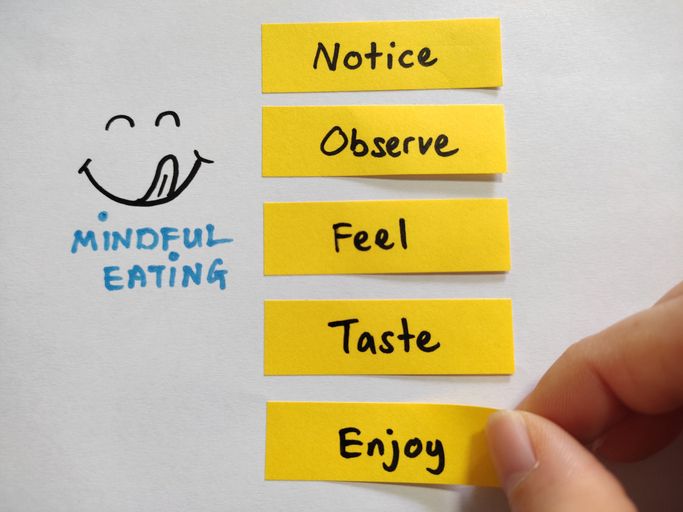
Author: Natalie Ng|Updated: 30 April 2025
Mindful eating helps you control your weight by focusing on how you eat, not just what you eat. You start noticing real hunger cues, slow down, and enjoy your food without distractions. This can help you eat less, feel more satisfied, and make healthier food choices. A lot of us eat without thinking—snacking while stressed, rushing meals, or eating out of habit. These patterns can lead to weight gain, emotional eating, or bingeing. Mindful eating helps you break that cycle. It’s about eating slower, paying attention, and making conscious choices. This approach can improve your relationship with food and support long-term weight control. It’s also used in managing eating disorders and diabetes. Want to change your eating habits for good? Keep reading to learn how mindful eating can help.

Understanding the Basics of Mindful Eating

Mindful Eating Focuses on How You Eat
Most people focus on what’s on their plate, but mindful eating is more about how you eat. It means paying attention to your eating habits—slowing down, eating without distractions, and tuning in to how your body feels.
Instead of eating out of stress or boredom, mindful eating encourages you to listen to your body’s physical hunger cues. You notice when you're actually hungry, when you’re full, and what your body needs, rather than eating out of habit.
Practice Mindful Eating by Being Present
Mindful eating asks you to focus solely on your food. That means no phones, no screens, and no eating in a rush. Sit down at the dining room table, take a few deep breaths, and bring your attention to the meal in front of you. Pay attention to the texture, taste, and smell. This helps prevent mindless eating and encourages healthier food choices.
You’ll start to notice your body’s satiety cues more clearly, making it easier to stop eating when you're full. Eating slower also helps with digestion and reduces the urge to overeat.
Mindful Eating Encourages a Healthier Relationship with Food
By eating mindfully, you begin to understand your own eating behaviors—like emotional eating, binge eating, or reaching for junk food during stress. Over time, this can help reduce disordered eating patterns and support healthier eating behaviors.
Mindful eating isn’t about following strict rules. It’s about trusting your own body and creating more mindful eating habits that support weight management, improve your mental health, and promote healthy eating long term.

Breaking the Cycle of Emotional Food Choices

Recognize Your Trigger Foods
Emotional eating often starts with certain foods—ones you turn to when you’re stressed, anxious, or upset. These trigger foods are usually high in sugar, salt, or fat and are easy to overeat without thinking. You might crave them for comfort, not because you’re physically hungry.
To spot your trigger foods, try keeping a food and mood journal. Write down what you eat, when you eat, and how you feel before and after. Over time, you’ll notice patterns. For example, maybe you always reach for chocolate when you're anxious or snack on chips when you’re bored.
Once you identify your triggers, you can make small changes. You might choose not to keep certain foods at home or swap them for healthier options. This isn’t about cutting out your favorite snacks forever—it’s about taking control of your eating habits and making more mindful food choices.
Managing Stress Without Eating
Food often becomes a quick fix when stress hits, but there are better ways to cope. Learning to respond to emotions without eating can help you stop the cycle of emotional eating and build healthier eating behaviors.
Build a simple stress toolkit. This can include things like going for a short walk, calling a friend, journaling, or listening to music. These small actions can give your mind and body a break without turning to food.
Replacing emotional eating with non-food strategies helps rewire your habits. Over time, your brain learns that comfort doesn’t have to come from food. If you’re finding it hard to manage stress on your own, talking to a therapist can help. Professional support is a useful part of breaking disordered eating patterns and improving mental health.
Read More
Book Now to Experience
S6 Body Sculpting Treatment
1 Minute Self-Registration
Date should not be before minimal date

Key Techniques and Science Behind Mindful Eating

1. Create a Calm, Distraction-Free Space
Mindful eating starts with your environment. Choose a quiet, uncluttered place to eat. Sit down at a dining table with proper utensils and real plates, even for a quick snack. Turn off screens and silence notifications. Distractions like phones or TVs often lead to mindless eating and make it harder to notice when you're full.
A distraction-free space helps you focus on your food. You become more aware of what and how much you’re eating, which supports healthier eating habits and weight control. Natural lighting and a clean setting can also help you stay present and engage all your senses.
2. Pause Before Eating and Check In
Before your first bite, take a moment to observe your food. Look at the colors and textures. Notice how it smells. This short pause helps shift your focus to the present moment and prepares your mind to eat slowly and with awareness.
Use this time to check in with your body. Are you truly hungry? Or are you eating out of habit or emotion? These small check-ins support better food choices and help reduce emotional or distracted eating.
3. Eat Slowly and Listen to Your Body
Chew thoroughly—20 to 30 times per bite if you can. Put your utensils down between bites. Eating slowly gives your brain time to register satiety signals, which takes about 20 minutes. When you slow down, you're more likely to stop eating before you're overly full.
This natural regulation of food intake supports weight management and helps prevent binge eating or unnecessary snacking. It also reduces the urge to eat out of stress, as eating slowly naturally calms the nervous system.
4. Stay Focused During the Meal
Bring your attention to each bite. Notice the flavor, texture, and how the food feels in your mouth. If your mind starts to wander, gently guide it back to the experience of eating. Staying present helps you enjoy your food more and makes it easier to stop eating when you're full.
This habit strengthens the connection between your mind and body, helping you distinguish between physical hunger and emotional cravings—key to changing long-term eating behaviors.
Why It Works: The Science
Mindful eating activates satiety cues from your digestive system to your brain. When you eat slowly, your brain has enough time to receive signals that you're full. This helps prevent overeating and supports steady weight loss or maintenance without strict calorie counting.
Research also shows that mindful eating lowers cortisol levels—the stress hormone linked to emotional eating and belly fat. Staying calm during meals improves digestion and helps reduce food cravings driven by stress.
Finally, brain scans show that mindful eating strengthens the prefrontal cortex—the part of your brain that handles impulse control and decision-making. This means you're more likely to make thoughtful, healthier food choices, not automatic or emotional ones.

Relationship Between Mindful Eating and Weight Management

Mindful Eating Activates Satiety Signals
When you practice mindful eating, you give your body time to catch up with your food intake. It takes about 20 minutes for your brain to receive signals from your stomach that you're full. Eating slowly allows this natural process to happen, helping you stop eating before you feel overly full.
This awareness supports better portion control and reduces the chance of overeating. Over time, it contributes to more consistent weight loss or weight maintenance without needing strict diets.
Mindful Eating Reduces Stress and Emotional Eating
Eating mindfully also reduces stress-related eating. When you're calm during meals, your digestive system works more efficiently. This improves how your body absorbs nutrients and helps prevent emotional eating, which often leads to unhealthy food choices.
Research shows that mindful eaters often have lower levels of cortisol—the hormone linked to stress and belly fat. This makes mindful eating a useful tool for those dealing with emotional hunger or disordered eating behaviors.
Mindfulness Strengthens Decision-Making
Studies using brain scans have shown that mindful eating strengthens the prefrontal cortex, the part of the brain responsible for self-control and decision-making. This means you're more likely to make healthier food choices instead of reacting on impulse.
It also helps build a stronger connection between your mind and body. You start noticing the difference between physical hunger and emotional cravings. That awareness is key to changing eating behaviors in a lasting way.
Book Now to Experience
S6 Body Sculpting Treatment
1 Minute Self-Registration
Date should not be before minimal date

Recognizing True Hunger vs. Habitual Eating

Physical vs. Emotional Hunger
One of the most important mindful eating habits is learning to tell the difference between physical hunger and emotional hunger. Physical hunger builds slowly. You might feel your stomach growl, your energy drop, or mild discomfort that signals your body needs fuel. Once you eat enough, the hunger fades.
Emotional hunger feels different. It comes on fast and usually makes you crave specific comfort foods—often high in sugar, fat, or salt. You might still eat even if you're full, especially when you're stressed, bored, lonely, or upset. And unlike physical hunger, emotional eating doesn’t stop when you're full—it continues until you're distracted or uncomfortable.
To build healthier eating habits, pause before eating and ask yourself: Am I truly hungry? Or am I eating to cope with a feeling?
Listen to Body Signals
Learning to trust your body takes practice. Start by looking for real physical cues like a growling stomach, a slight dip in energy, or a hollow feeling in your belly. These are signs of true hunger.
Habitual eating, on the other hand, often happens just because it's a certain time of day, you're around food, or someone else is eating. It's not about hunger—it's just a pattern.
Try rating your hunger on a scale of 1 to 10 before each meal. This helps you pause and check in, so you can respond to your body rather than your environment or emotions.
Break Mindless Eating Patterns
To stop eating out of habit, you need to understand what triggers it. Do you snack when you're bored? Do you always eat something sweet after dinner, even if you're full? Track these patterns by writing down when and why you eat.
Once you notice the pattern, try replacing it with something else. If you eat while watching TV, pause the show and eat before or after. If stress makes you reach for food, go for a walk or write in a journal instead.
Breaking these old patterns makes space for more mindful eating behaviors. Over time, you’ll eat based on physical hunger—not out of habit or emotion.

Mindful Portion Control Strategies

1. Use Simple Visual Cues Instead of Counting
You don’t need to weigh your food or count calories to manage your portions. Mindful eating uses easy visual guides that help you stay aware of how much you’re eating without feeling restricted.
Use your hand as a quick reference:
• Your palm is a good guide for a protein portion
• Your cupped hand can measure carbohydrates
• Your thumb represents a serving of fats
• Your fist is a rough guide for vegetables
These simple cues help you build balanced meals and reduce the chance of overeating, especially when eating different foods or away from home.
2. Choose Smaller Plates and Bowls
Using smaller plates helps with portion control naturally. You’ll likely serve yourself less and still feel satisfied because your brain sees a full plate. This small change reduces food intake without requiring you to consciously restrict yourself.
Filling half your plate with vegetables first is another easy way to control portions while increasing nutrient intake. Vegetables are low in calories and high in fiber, helping you feel full longer.
3. Pause Midway Through Your Meal
Halfway through eating, stop and check in with your body. Put your utensils down and ask yourself:
• Am I still hungry?
• Is this still enjoyable?
• Am I eating just to finish what's on my plate?
Often, you’ll realize you’re already satisfied and don’t need more. You’re not wasting food by stopping—you’re responding to your body’s signals.
Learning to leave food behind, when you’ve had enough, is a key part of building healthier eating behaviors. It helps prevent overeating and supports long-term weight management without the stress of strict rules.
Book Now to Experience
S6 Body Sculpting Treatment
1 Minute Self-Registration
Date should not be before minimal date

Overcoming Common Mindful Eating Challenges

Emotional Eating
Emotional eating can feel automatic, especially when you're stressed, tired, or upset. You may eat without thinking, even when you're not physically hungry. The key is to pause and ask yourself: What am I really feeling?
If you're not physically hungry, try a different response. Take a short walk, write in a journal, or talk to a friend. These small shifts help break emotional eating patterns and support healthier eating habits. Repeating this step builds new habits over time and reduces your reliance on food for comfort.
Time Pressure
A common barrier to mindful eating is feeling like you don’t have time. If your schedule is packed, try starting with just one mindful meal per day. It doesn’t have to be perfect—just sit down, eat without distractions, and slow down a bit.
You can also set a timer for 15–20 minutes to help pace your meals. This encourages you to eat slower, pay attention to your body's satiety cues, and reduce overeating—even if you’re short on time.
Social Pressure
Eating with others can challenge mindful habits, especially if there’s pressure to eat more or try everything. You might feel obligated to clean your plate or match someone else's pace.
It’s okay to eat at your own speed, take smaller portions, or say no to seconds. You’re allowed to make choices based on your needs, not social expectations. These decisions help reinforce mindful eating behaviors in any setting.
Learning to manage these common challenges doesn’t mean you have to be perfect. Every time you pause, check in with your body, or choose a different response, you’re strengthening your ability to eat mindfully.

Incorporating Mindfulness Into Daily Meals

Start with a Distraction-Free Setup
Choose a quiet place where you can eat without distractions. Turn off your TV, silence your phone, and step away from your computer. This helps you focus on your meal and stay present. Even one distraction-free meal a day can begin to change your eating habits.
Sit at a table rather than eating on the couch or at your desk. Use a proper plate and utensils. A calm, intentional setup supports better attention to your food and helps reduce mindless eating.
Use All Your Senses
Before eating, take a few moments to observe your food. Notice its colors, textures, and smell. This helps shift your attention away from stress or distractions and brings your focus to the present moment.
As you eat, chew slowly and take note of how the food feels and tastes. Stay curious about each bite. When your mind starts to wander, gently bring your focus back to your food.
Check In Throughout the Meal
As you eat, pause to ask yourself:
• Am I still hungry?
• Am I eating because I’m bored or stressed?
• Is the food still enjoyable?
These small moments of awareness help you better understand your eating patterns and reduce the risk of overeating or eating out of habit.
Build Consistency Over Time
You don’t need to change everything at once. Start with one meal or snack each day where you eat mindfully. With regular practice, mindful eating becomes more natural and leads to healthier food choices, better portion control, and a stronger connection with your body.

Supporting Mindful Eating with S6 Body Sculpting Treatment
Mindful eating helps you reconnect with your body’s natural hunger cues and make better food choices. But sometimes, even with healthy eating habits, certain areas of stubborn fat remain difficult to reduce. That’s where S6 Body Sculpting Treatment can help.
This non-invasive treatment works alongside mindful eating by targeting specific areas of body fat that don’t respond well to diet alone. While mindful eating focuses on changing eating behaviors and building a healthy relationship with food, S6 supports your progress by speeding up fat reduction in the most challenging spots—like the belly, thighs, arms, and back.
What Is S6 Body Sculpting Treatment?
S6 is a non-surgical body contouring treatment that uses a low-energy bio-laser to target fat cells. The laser penetrates into the subcutaneous fat layers, breaking down fat cells and releasing fatty acids for natural drainage through the lymphatic system. At the same time, vacuum suction is used to stimulate blood flow and increase your body’s metabolic rate.
It doesn’t stop there—the same laser energy helps stimulate collagen production, which tightens the skin and reduces sagging after fat loss.
How S6 Treatment Enhances Mindful Eating
Mindful eating encourages you to eat slowly, recognize fullness, and avoid emotional or binge eating. These habits reduce food cravings and help maintain a healthy body weight over time. But for many, fat stored in certain areas can feel discouraging—especially when it doesn’t go away with diet changes alone.
S6 helps by directly addressing these trouble spots. It offers a physical boost to complement your mindful eating efforts, helping you stay motivated and feel confident in your body.
Benefits of S6 Body Sculpting Treatment
• Targets stubborn fat in common areas like the belly, waist, thighs, arms, and back
• Non-invasive: no surgery, needles, or long recovery time
• Stimulates collagen to improve skin texture and firmness
• Boosts metabolism and supports natural fat elimination
• Comfortable and safe for most body types
This treatment is especially helpful for those who have developed healthy eating behaviors but still struggle with specific fat deposits due to genetics, lifestyle, or previous weight gain.
How Many Sessions Are Needed?
Most people benefit from 10 to 12 sessions, with a month between each visit. Our trained therapists will assess your body and goals to create a personalized plan.
Who Should Consider It?
If you're practicing mindful eating and want to improve your body shape, reduce localized fat, and avoid surgery, this treatment may be a good fit. It’s suitable for most healthy adults but not recommended for those who are pregnant or managing certain medical conditions.
Combining mindful eating habits with treatments like S6 can lead to visible changes and lasting results. If you're ready to support your weight control journey with an extra boost—without surgery or downtime, book your S6 Body Sculpting consultation today.
New Beauty's S6 Body Sculpting TreatmentBook Now to Experience
S6 Body Sculpting Treatment
1 Minute Self-Registration
Date should not be before minimal date
FAQ
Can Mindful Eating Help With Specific Food Allergies or Intolerances?
You'll find mindful eating can help you identify foods that trigger allergic reactions or intolerances. When you eat slowly and deliberately, you're more tuned in to your body's signals and responses. You'll notice patterns between specific foods and symptoms, making it easier to pinpoint problematic ingredients and make informed choices about what to eat or avoid.
How Does Mindful Eating Affect Metabolism and Digestion Rates?
When you eat mindfully, you activate your body's ideal digestive response. You'll notice improved metabolism as your parasympathetic nervous system engages, enhancing nutrient absorption and digestive enzyme production. By chewing thoroughly and eating slowly, you break down food more effectively, reducing digestive stress. Your body processes nutrients more efficiently when you're present and relaxed during meals, rather than rushing through them.
Does Mindful Eating Work When Dining at Restaurants or Social Events?
Don't let eating out throw you for a loop! You can practice mindful eating anywhere, even in social settings. Take your time selecting menu items, put your fork down between bites, and engage in conversation while savoring your food. You'll find that dining mindfully helps you tune into hunger signals, make better choices, and fully experience your meal without overindulging, regardless of the environment.
Can Children Benefit From Mindful Eating Practices?
You'll find that children can greatly benefit from mindful eating practices. Teaching kids to listen to their hunger cues, slow down while eating, and appreciate their food builds healthy lifelong habits. You can make it fun by turning it into a sensory game - exploring colors, textures, and flavors. When you encourage mindful eating early, children develop a better relationship with food and their bodies.
How Long Does It Take to See Weight Loss Results With Mindful Eating?
You'll typically notice initial changes in your eating habits and relationship with food within 2-4 weeks of practicing mindful eating. Physical weight changes usually become apparent after 6-12 weeks of consistent practice. Remember, mindful eating isn't a quick fix - it's about creating lasting freedom from impulsive eating patterns. Your results will vary based on your starting point and how fully you embrace the practice.
Recommended Articles
COPYRIGHT© NEW BEAUTY MANAGEMENT LIMITED 2025. ALL RIGHT RESERVED.




